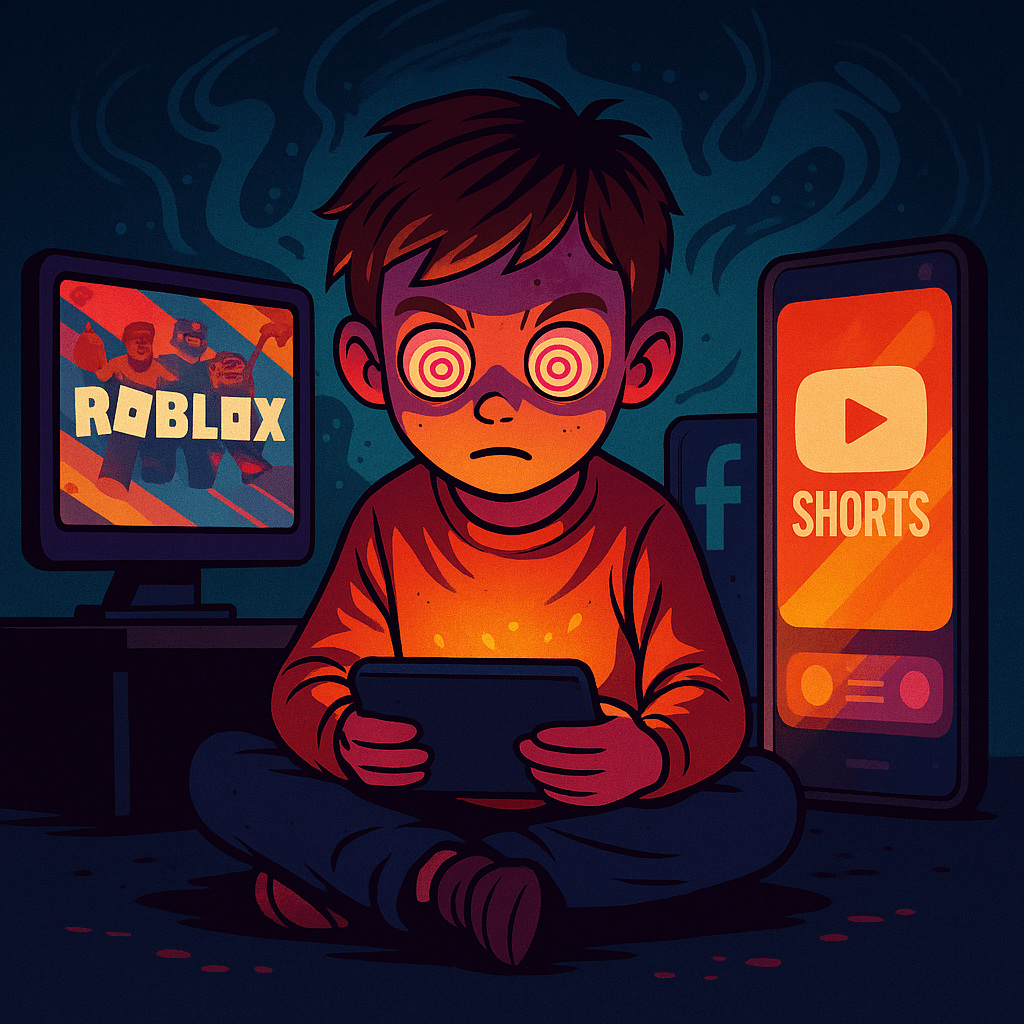Is Digital Dopamine Destroying Kids’ Brains? Roblox, YouTube Shorts & the New Age of “Brainrot”

In 2025, the phrase “kids are addicted to their screens” is no longer a throwaway line—it’s a legitimate public health concern. Parents everywhere are witnessing a terrifying transformation: children who once played outdoors and read books are now glued to hyper-stimulating platforms like Roblox, YouTube Shorts, TikTok, and Facebook Reels. This is no longer just about “too much screen time.” We’re seeing early signs of what experts are calling “digital brainrot.”
The growing concern over kids brainrot from Roblox and short videos is more than just internet slang—it’s a real cognitive health crisis that parents can no longer ignore.
What Is “Brainrot”? Why the Term Is Trending
“Brainrot” is an unofficial but widely used internet slang term that describes a state of cognitive decline associated with excessive consumption of overstimulating content—especially short, dopamine-heavy media. Google Trends shows the term surging in late 2023, and it continues to trend in 2025.
While not yet medically classified, researchers and psychologists link it to ADHD, anxiety, emotional dysregulation, and reduced working memory—symptoms also highlighted in reports from the American Psychological Association APA, 2025.
Roblox and Its Role in Cognitive Decline
What Makes Roblox So Addictive?
Roblox is more than a game—it’s an immersive digital universe with millions of microgames, each designed to capture short attention spans, deliver instant rewards, and promote continuous engagement.
According to The Guardian’s 2025 investigative report, Roblox’s design raises serious concerns due to its gambling-style reward systems, unsafe social features, and addictive mechanics. Children under 13 now account for more than 60% of Roblox’s player base, with many spending hours in dopamine loops without structured end-goals.
Dr. Emma Farrell’s study published in JAMA Pediatrics 2025 links heavy Roblox use with increased impulsivity and decreased working memory among kids aged 7–12. These findings mirror the brainrot symptoms frequently observed by educators and parents alike.
The Rise of Short-Form Content: YouTube Shorts, Facebook Reels & TikTok
Short-form video is dominating kids’ digital consumption. YouTube Shorts racks up over 70 billion daily views globally (Alphabet Q2 2025 report). TikTok and Facebook Reels follow closely.
These videos are:
-
Fast-paced and visually intense
-
Emotionally charged and low in narrative complexity
-
Engineered to trigger immediate dopamine spikes
A landmark study by the Chinese Academy of Sciences in 2025 found that kids who watched 60+ minutes of short-form videos daily showed reduced attention spans and lower academic performance (Digital Information World, 2025).
The Dopamine Trap: A Chemical Hijack of Young Brains
Short-form videos and Roblox games overstimulate the reward circuits of the brain, training it to expect constant novelty.
Dr. Nora Volkow from the National Institute on Drug Abuse explains that these changes resemble early-stage addiction: elevated dopamine baselines, increased irritability, and desensitization to slow, focused activities like reading.
Further evidence from Museo dei Bambini (2025) highlights brain imaging studies showing decreased gray matter density in areas linked to sustained attention and decision-making.
Symptoms of Digital Brainrot in Kids
Key signs:
-
Agitation when devices are removed
-
Disinterest in books or toys
-
Inability to complete multi-step tasks
-
Sleep disturbances
-
Emotional outbursts
The APA found that children exposed to excessive screen time displayed symptoms overlapping with ADHD and anxiety disorders (APA, 2025).
Attention Span Crisis: The New Normal?
The 2025 OECD Global Learning Survey found a 46% drop in sustained attention span in children under 12 compared to 2010.
An experiment on ArXiv (2023) showed that short-form video viewing significantly impairs prospective memory—the ability to remember to do tasks after delays.
Children are now conditioned to reset their focus every few seconds, disrupting long-term goal planning and learning.
Parental Guilt vs. Big Tech’s Profit Machines
Parents are up against billion-dollar platforms that use algorithmic behavioral prediction, AI attention hacking, and infinite scroll to trap users.
Even schools rely on tablets and Chromebooks, making it nearly impossible to implement total abstinence.
Real Cases: Kids in Crisis
Emily, 9: Developed anxiety and insomnia after Roblox access was restricted.
Jasper, 11: Failed multiple classes after six-hour daily YouTube Shorts binges.
Mila, 8: Exhibited obsessive TikTok phrase repetition and struggled with reading.
These are just a few examples echoing a global pattern backed by data from AECF.org.
The Science of Cognitive Decline
A 2022 review on ScienceDirect found that even one hour of daily screen time in preschoolers resulted in measurably lower cognitive task scores.
Dr. Alexander Ng (UCL, 2024) reported that kids watching 100+ short-form clips daily scored lower on IQ tests measuring logic and verbal reasoning.
The Socialization Effect
Kids absorbed in digital content often struggle with:
-
Empathy and reading emotional cues
-
Conversational turn-taking
-
Tone recognition
Meta-analysis summaries on Wikipedia show strong links between screen overuse and increased social anxiety, depression, and sleep disruption.
What Can Parents Do?
1. Digital Fasting
Establish 1–2 screen-free days weekly and offer real-world alternatives.
2. Dopamine Reset
Gradually reduce screen time over several weeks.
3. Smart Substitution
Replace Roblox with:
-
Minecraft (Creative Mode)
-
Board games
-
Code.org
4. Use Parental AI Tools
Apps like Qustodio, Bark, and Google Family Link now monitor stimulation thresholds and screen exposure.
5. Work with Educators
Promote screen-balanced classroom guidelines.
Can We Undo the Damage?
Yes—but only if we start now.
The conversation around kids brainrot from Roblox and short videos is not just cultural—it’s biological and developmental. Children’s brains are malleable, and with the right changes, recovery is possible.
Set limits. Talk openly. Encourage real-world curiosity.
Key Takeaways
-
Roblox and short-form media exploit children’s dopamine systems.
-
Documented side effects include reduced attention, impulsivity, and poor social skills.
-
Parents and educators must lead the effort to rebalance children’s digital diets.
Sources






















